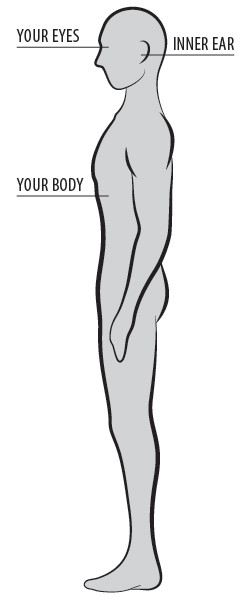Don’t Let Dizziness Throw Off Your Life’s Balance
Dizziness or loss of balance, sometimes referred to as vertigo, is the second most common complaint that doctors hear. According to the National Institutes of Health, dizziness will occur in 70 percent of Americans at some point in their lives. Whether the dizziness is fleeting or chronic may indicate how serious the potential health risks are to you as an individual.
Equilibrium disorders typically fall into two categories:
- Acute attacks of dizziness, vertigo, or a general loss of balance that may last a few seconds or a few hours
- A persistent sense of imbalance, unsteadiness, or what some people refer to as a loss of sure-footedness
Facts About Dizziness and Balance
- Loss of balance will affect 90 million Americans at some point during their lives.
- More than 9 million people each year consult their physicians to find solutions to their dizziness, which is the No. 1 complaint for individuals over age 70.
- Balance-related falls account for more than half of all accidental deaths in the elderly population, and they cause more than 300,000 hip fractures each year in individuals over age 65.
- Some inner-ear disorders, like Ménière’s disease or benign positional vertigo, have symptoms that are virtually indistinguishable to most people. Because of how they affect an individual’s ability to stand, walk, see clearly, think clearly, read, watch television, and make decisions, these disorders are often misdiagnosed as multiple sclerosis and clinical depression.
- Children with treatable balance disorders are sometimes incorrectly diagnosed as learning disabled, dyslexic, or psychologically disturbed.
- Head trauma and whiplash are frequent causes of dizziness.
- Ear infections can also cause vestibular disorders.
How Your Balance System Works
Your ability to achieve and maintain balance depends on your brain coordinating input from three sources, integrating the input, and sending output to your eyes and muscles. The three sources are:
- Vision. Your eyes send information to your brain about where you are relative to the objects around you.
- Proprioception. This ten-dollar word is simply your body’s ability to sense movement, action, and location. Your skin, muscles, and joints constantly send messages to your brain about what position you’re in and what you’re doing.
- Vestibular system. This is named for the vestibule, a part of your inner ear. This system is responsible for providing your brain with information about your head’s motion, equilibrium, and spatial orientation. There are many small structures that all work together to constantly send your brain information.
Your brain sorts all this data and combines it with information from the parts of your brain responsible for coordination, thinking, and memory. Then it sends messages that control the movements of your eyes, head and neck, torso, and legs to ensure continued balance.
When your balance system works properly, you see clearly while moving, stay oriented with respect to gravity, know your direction and speed, and automatically make posture adjustments to maintain stability.

Causes of Balance Problems
For many people, balance problems set in because of age-related issues such as cardiovascular disease, stiff or damaged joints, or an autoimmune condition. But the inner ear is the most common source of these disorders for all ages, from fluid imbalances to bone damage.
Symptoms range from short and mild to chronic and debilitating. Some common ones are general unsteadiness, vertigo (a spinning sensation), noise or light sensitivity, nausea, coordination problems, and concentration or memory issues.
Diagnosing Balance Issues
Many systems and sources contribute to balance — and interact with yet other systems. That’s why diagnosis is often not straightforward. Below are some ways a medical professional might help determine the challenges you are experiencing.
Videonystagmography (VNG)
This test tells your provider if your brain is getting conflicting messages from your eyes and inner ears. You wear goggles that monitor your eye movements and perform tasks such as following a target and placing your head and body into different positions.
Rotation tests
There are different kinds of rotation tests, but they all provide information about how well your inner ears and eyes work together. You wear goggles or electrodes and your head moves (usually slowly) while your audiologist monitors your eye movements.
Video head impulse test (vHIT)
This also provides information about how well your inner ears and eyes work together. You wear goggles or electrodes, your head moves, and your audiologist monitors your eye movements. The major difference is the head movements are very slight and faster.
Vestibular evoked myogenic potential (VEMP)
VEMP testing evaluates whether certain balance structures and associated nerves are intact and working normally. The test uses adhesive, skin-surface electrodes on the neck and around the eyes as well as earphones like the ones during a hearing test.
Dynamic visual acuity (DVA) testing
DVA testing evaluates your ability to use your inner-ear balance system while your head moves. You identify a target on a computer screen while your head is still and then with your head moving.
Although you may feel helpless when you’re hit with a dizzy spell, there’s plenty of hope for these balance problems. Proper diagnosis and treatment options have been enhanced over the last decade, making dizziness a much easier problem to resolve.
While the connection between balance and your hearing may vary for each person, we want to help everyone avoid balance problems as much as possible, and we believe better hearing is one effective preventative measure. Learn more about how hearing and balance are related.
Frequently Asked Questions
How do I get rid of the dizziness?
Typically, symptoms resolve on their own, but treatment can be provided either in home or at a practice that treats balance issues. Alta View Audiology can help with your vertigo and other balance and dizziness disorders.
How long does vertigo last?
A vertigo attack may last only a few seconds, or a few hours. The condition itself may last only a matter of weeks, or it may be an ongoing problem. People with persistent, ongoing vertigo may be in danger of harming themselves or others, making treatment a necessity.
Why do I get dizzy when I stand up?
Blood pressure drops excessively when you sit or stand, causing dizziness. This dizziness can resolve rapidly within a few seconds if the person lies down. Some people do faint, however, and symptoms tend to be more common and worse after exercise, consuming alcohol, or eating a heavy meal. Low blood flow to the brain can cause dizziness and other symptoms, and is not necessarily a result of vertigo. Because reasons for dizziness vary depending upon specific medical conditions, individuals who experience excessive dizziness when shifting body positions are encouraged to contact our practice for a full consultation.
Read Our Latest Balance Articles
-

Start 2025 in Balance
Kick off the new year with confidence by improving your balance and hearing. Explore the…
-

5 Tips for Living with Balance Problems
Balance issues can sometimes feel like they’ve taken over. But what if there were some…
-

Q&A: Does Caffeine Affect Hearing and Balance?
Coffee and tea are two of the most popular drinks in the world, and most…
Got questions?
We’ve got answers and we’re standing by to help.